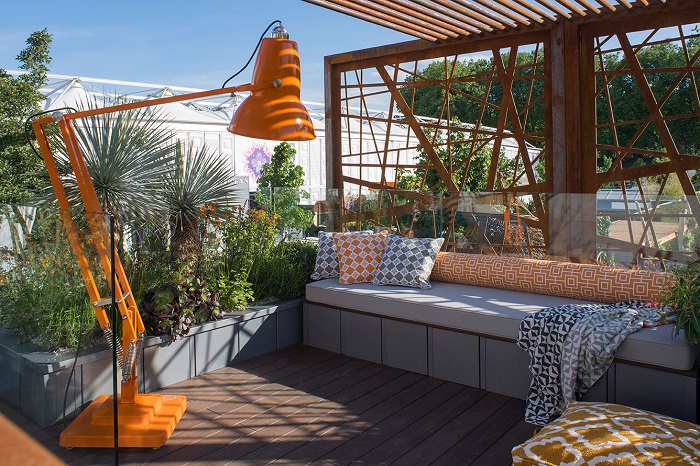Anglepoise lamp

|
| The classic Anglepoise seen here with stepped base. Photo: Helen Fickling |
As one of the product design icons of the 20th century, the Anglepoise lamp has had few design changes and still sports its original lines. It was first developed in England by George Carwardine as a useful application of an ingenious spring, crank and lever mechanism that he had invented while working in the car industry.
Born in bath, England, in 1887, Carwardine began life as an apprentice automotive engineer at the Horstmann Car company. Having risen through the ranks to chief designer, he set up his own car suspension systems consultancy (Cardine Accessories) in 1924. Although he returned for another stint at Horstmann, the company went bankrupt and Carwardine found he had the time to spend in his garden workshop developing his own designs.
Carwardine’s specialist knowledge of springs allowed him to develop a mechanism involving pivoting arms supported by a sequence of springs. This allowed the mechanism to be moved with the lightest of touches in x, y and z directions, yet be so well balanced it could remain stationary at any chosen point. The mechanism became the blueprint for what would become the Anglepoise lamp.
Carwardine patented his invention in 1932 and began manufacture of the four-spring model in 1933 calling it the Model 1208. However, such was the success of the lamp, demand proved too high and outstripped Cawardine’s small-scale manufacturing capacity. So, in 1934 he turned to specialist spring manufacturer Herbert Terry & Sons who already supplied the springs for his lamps, and to whom he would sell the manufacturing rights in 1934.
Originally designed for industrial applications, further work with Terry’s saw the creation of a slightly modified, lighter three-spring version (model 1227) for home and office use. The lamp, which he registered in 1947, and in the US in 1950, was eventually to become known as Terry’s Anglepoise, which the company still produces today.
Originally, Carwardine named the lamp ‘equipoise’ as it comprised four springs held in perfect equipoise to maintain the required position. However, he was unable to obtain the trademark as 'equipoise' was already a word in use as part of everyday language. Instead he registered the trademark Anglepoise in 1947.
Having achieved iconic status, the Anglepoise, like most products has undergone a process of continuous development. To the original design, Terry’s has added extended collections by various well-known industrial product designers, including Sir Kenneth Grange, and has also collaborated with the renowned designers Paul Smith and Margaret Howell.
Today, Anglepoise lamps can be found in homes, offices, restaurants, bars and hotels around the world.
[edit] Related articles on Designing Buildings Wiki
- Dichroic reflector.
- Discharge lamp.
- Extra-low voltage lamps.
- General lighting v task lighting.
- Glare.
- Health and wellbeing impacts of natural and artificial lighting.
- Human-centric lighting.
- Illuminance.
- Lamp efficacy.
- Light fitting.
- Lighting designer.
- Lighting energy numeric indicator LENI.
- Lighting for circadian rhythms.
- Lighting of construction sites.
- Luminaire efficacy.
- Luminous flux.
- Natural light.
- Procurement route.
- Types of lighting.
Featured articles and news
A change to adoptive architecture
Effects of global weather warming on architectural detailing, material choice and human interaction.
How big is the problem and what can we do to mitigate the effects?
Overheating guidance and tools for building designers
A number of cool guides to help with the heat.
The UK's Modern Industrial Strategy: A 10 year plan
Previous consultation criticism, current key elements and general support with some persisting reservations.
Building Safety Regulator reforms
New roles, new staff and a new fast track service pave the way for a single construction regulator.
Architectural Technologist CPDs and Communications
CIAT CPD… and how you can do it!
Cooling centres and cool spaces
Managing extreme heat in cities by directing the public to places for heat stress relief and water sources.
Winter gardens: A brief history and warm variations
Extending the season with glass in different forms and terms.
Restoring Great Yarmouth's Winter Gardens
Transforming one of the least sustainable constructions imaginable.
Construction Skills Mission Board launch sector drive
Newly formed government and industry collaboration set strategy for recruiting an additional 100,000 construction workers a year.
New Architects Code comes into effect in September 2025
ARB Architects Code of Conduct and Practice available with ongoing consultation regarding guidance.
Welsh Skills Body (Medr) launches ambitious plan
The new skills body brings together funding and regulation of tertiary education and research for the devolved nation.
Paul Gandy FCIOB announced as next CIOB President
Former Tilbury Douglas CEO takes helm.
UK Infrastructure: A 10 Year Strategy. In brief with reactions
With the National Infrastructure and Service Transformation Authority (NISTA).
Ebenezer Howard: inventor of the garden city. Book review.
Airtightness Topic Guide BSRIA TG 27/2025
Explaining the basics of airtightness, what it is, why it's important, when it's required and how it's carried out.





















